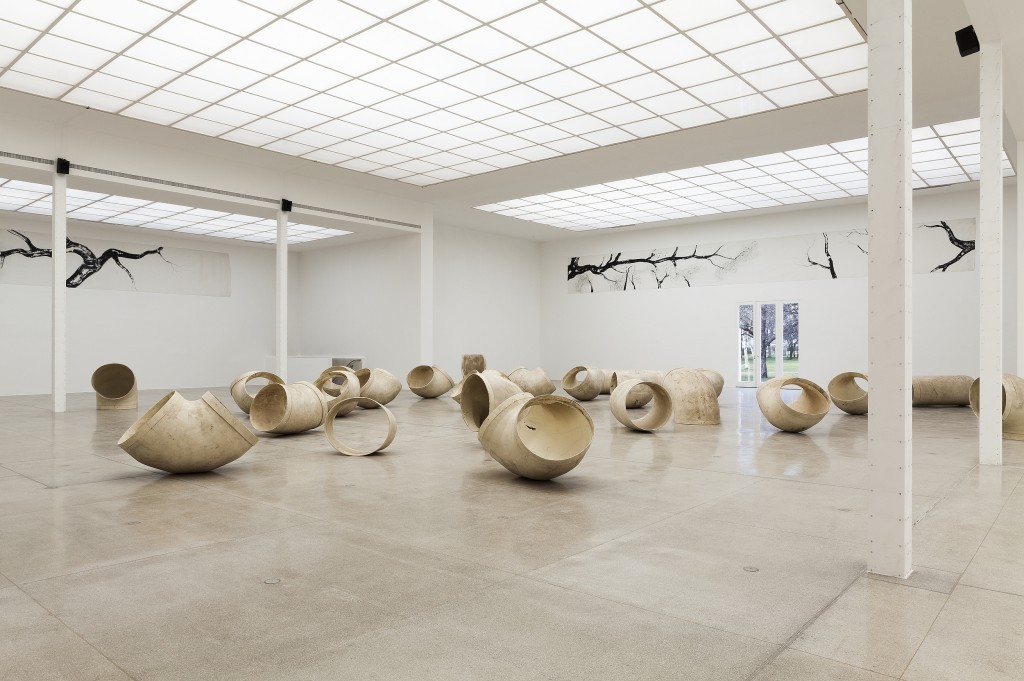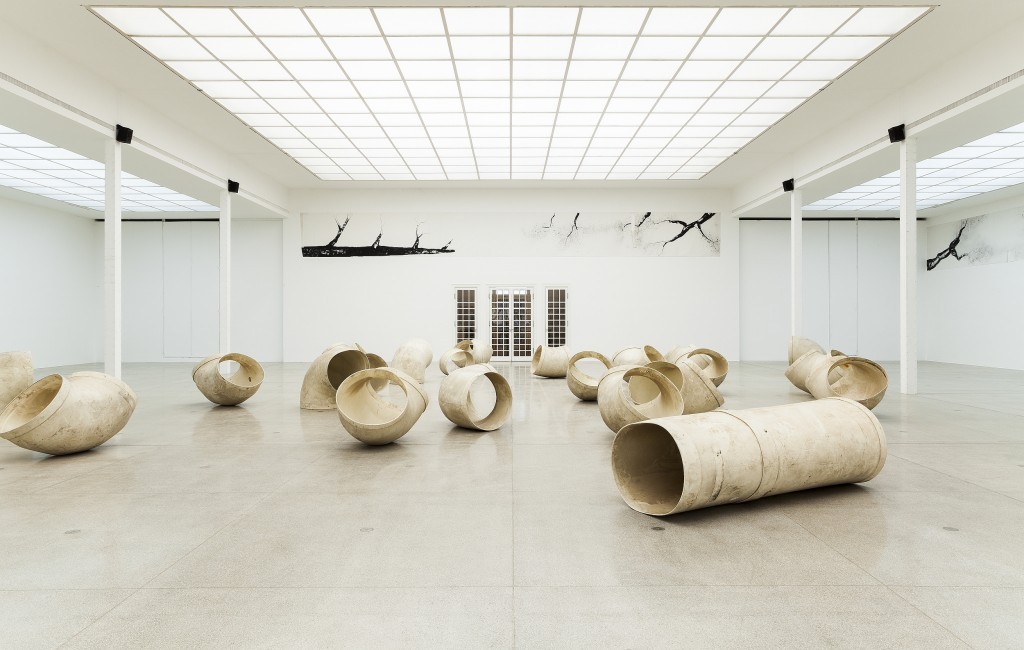Lutz Bacher
More Than This
12 Feb - 03 Apr 2016
LUTZ BACHER
More Than This
12 February – 3 April 2016
In a career spanning more than four decades, Lutz Bacher has built a highly heterogeneous oeuvre that defies classification. The American artist, who adopted her male pseudonym when she first started out, has produced conceptual work in a variety of media. Bacher’s photographs, sculptural arrangements, videos, sound pieces, and expansive installations incorporate images and objects that are fixed in collective memory and easily retrieved: press photographs of public figures that, copied several times over, begin to lead a strangely aesthetic new life, everyday stuff and detritus from thrift shops she integrates into her installations as objets trouvés and secondhand readymades, or time-worn baseballs, marbles, and sand. Her appropriations draw on trivial pop culture sources such as dime novels, porn magazines, self-help literature, and paparazzi snapshots, and occasionally include references to art history. The human body, sexuality, power, and violence are key issues in her art, as are our current state of being and the deliberate blurring of the line separating the private from the public sphere.
For the large-format works in the Jokes series (1987–88), Bacher enlarged black-and-white photographs of 1970s politicians and celebrities with often crude one-liners. The scruffy look of the pictures—the artist smeared them with dirt and drove her car over them—emphasizes the critical overtones of the series. In Closed Circuit (1997–2000), a forty-minute animation composed of video stills, she created a portrait of Pat Hearn, the gallerist who had represented her for many years: a surveillance camera positioned above Hearn’s desk recorded everything she did—make phone calls, work, think, write, etc.—for almost a year. Hearn had recently received a diagnosis of cancer, and so Closed Circuit is not only a document of the day-to-day gallery business, but also bears witness to one of the last years in Hearn’s life.
Through abstraction, fragmentation, and the arrangement of things in unwonted orders, Bacher raises questions concerning the standardizing pressures that shape social models of identity and our individual life choices, confronting our preference for conformity with piles of sand, coal slag, or thousands of loose marbles in the exhibition space to create situations of literal as well as metaphorical instability: everything, we sense, may change in an instant. For her installation The Book of Sand (2012), she had twenty-five tons of sand transported to the Alex Zachary Peter Currie gallery in New York, where it covered the floor throughout the gallery’s downstairs space and spread out into the courtyard. Unlike Walter De Maria’s permanent installation New York Earth Room (1977) in SoHo, Bacher’s work was meant to be walked over; visitors’ footprints as well as the light coming in through the gallery’s windows lent the installation a constantly changing appearance.
More Than This (2016), Lutz Bacher’s new installation in the Secession’s main hall, is composed of a loose arrangement of found objects: a bunch of large tube joints made of industrial plastic and covered with dust and dirt are scattered over the floor, while a fragmented frieze runs across the walls, not without slight disruptions. The black-and-white painting shows stylized, leafless branches and twigs. Like the tubes littering the floor, the canvases have signs of usage like inexplicable cuts and tattered holes as the primary use of these apparently broken tools remains obscured. In this fresh setting, sure enough they may gain new meaning. The exhibition space and its visitors are immersed in the ambient sound of birdsong and the almost imperceptibly gradually changing light: two subtle interventions that nevertheless affect how the situation is perceived.
Finally, with I’m Yours (2015), the installation continues in the exhibition space dedicated to Gustav Klimt’s Beethoven Frieze. The video shows a man playing the piano amid the everyday bustle of a train station. Paradoxically, he seems to be both present and absent as he is completely absorbed in his action, incessantly striving to play Beethoven’s Moonlight Sonata without taking any note of his surroundings. The viewer becomes a witness to an intimate performance in public space.
The artist’s book the Gift designed by Lutz Bacher is published in conjunction with her solo show.
More Than This
12 February – 3 April 2016
In a career spanning more than four decades, Lutz Bacher has built a highly heterogeneous oeuvre that defies classification. The American artist, who adopted her male pseudonym when she first started out, has produced conceptual work in a variety of media. Bacher’s photographs, sculptural arrangements, videos, sound pieces, and expansive installations incorporate images and objects that are fixed in collective memory and easily retrieved: press photographs of public figures that, copied several times over, begin to lead a strangely aesthetic new life, everyday stuff and detritus from thrift shops she integrates into her installations as objets trouvés and secondhand readymades, or time-worn baseballs, marbles, and sand. Her appropriations draw on trivial pop culture sources such as dime novels, porn magazines, self-help literature, and paparazzi snapshots, and occasionally include references to art history. The human body, sexuality, power, and violence are key issues in her art, as are our current state of being and the deliberate blurring of the line separating the private from the public sphere.
For the large-format works in the Jokes series (1987–88), Bacher enlarged black-and-white photographs of 1970s politicians and celebrities with often crude one-liners. The scruffy look of the pictures—the artist smeared them with dirt and drove her car over them—emphasizes the critical overtones of the series. In Closed Circuit (1997–2000), a forty-minute animation composed of video stills, she created a portrait of Pat Hearn, the gallerist who had represented her for many years: a surveillance camera positioned above Hearn’s desk recorded everything she did—make phone calls, work, think, write, etc.—for almost a year. Hearn had recently received a diagnosis of cancer, and so Closed Circuit is not only a document of the day-to-day gallery business, but also bears witness to one of the last years in Hearn’s life.
Through abstraction, fragmentation, and the arrangement of things in unwonted orders, Bacher raises questions concerning the standardizing pressures that shape social models of identity and our individual life choices, confronting our preference for conformity with piles of sand, coal slag, or thousands of loose marbles in the exhibition space to create situations of literal as well as metaphorical instability: everything, we sense, may change in an instant. For her installation The Book of Sand (2012), she had twenty-five tons of sand transported to the Alex Zachary Peter Currie gallery in New York, where it covered the floor throughout the gallery’s downstairs space and spread out into the courtyard. Unlike Walter De Maria’s permanent installation New York Earth Room (1977) in SoHo, Bacher’s work was meant to be walked over; visitors’ footprints as well as the light coming in through the gallery’s windows lent the installation a constantly changing appearance.
More Than This (2016), Lutz Bacher’s new installation in the Secession’s main hall, is composed of a loose arrangement of found objects: a bunch of large tube joints made of industrial plastic and covered with dust and dirt are scattered over the floor, while a fragmented frieze runs across the walls, not without slight disruptions. The black-and-white painting shows stylized, leafless branches and twigs. Like the tubes littering the floor, the canvases have signs of usage like inexplicable cuts and tattered holes as the primary use of these apparently broken tools remains obscured. In this fresh setting, sure enough they may gain new meaning. The exhibition space and its visitors are immersed in the ambient sound of birdsong and the almost imperceptibly gradually changing light: two subtle interventions that nevertheless affect how the situation is perceived.
Finally, with I’m Yours (2015), the installation continues in the exhibition space dedicated to Gustav Klimt’s Beethoven Frieze. The video shows a man playing the piano amid the everyday bustle of a train station. Paradoxically, he seems to be both present and absent as he is completely absorbed in his action, incessantly striving to play Beethoven’s Moonlight Sonata without taking any note of his surroundings. The viewer becomes a witness to an intimate performance in public space.
The artist’s book the Gift designed by Lutz Bacher is published in conjunction with her solo show.


